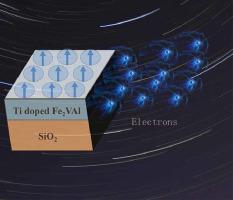当前位置:
X-MOL 学术
›
Acta Mater.
›
论文详情
Our official English website, www.x-mol.net, welcomes your
feedback! (Note: you will need to create a separate account there.)
Significant Off-Stoichiometry Effect Leading To the N-Type Conduction and Ferromagnetic Properties in Titanium Doped Fe2VAl Thin Films
Acta Materialia ( IF 8.3 ) Pub Date : 2020-11-01 , DOI: 10.1016/j.actamat.2020.09.067 Weihong Gao , Zihang Liu , Takahiro Baba , Quansheng Guo , Dai-Ming Tang , Naoyuki Kawamoto , Ernst Bauer , Naohito Tsujii , Takao Mori
Acta Materialia ( IF 8.3 ) Pub Date : 2020-11-01 , DOI: 10.1016/j.actamat.2020.09.067 Weihong Gao , Zihang Liu , Takahiro Baba , Quansheng Guo , Dai-Ming Tang , Naoyuki Kawamoto , Ernst Bauer , Naohito Tsujii , Takao Mori

|
Abstract Thermoelectric thin films are of great interest for self-powering Internet of Things (IoT) nodes via energy harvesting. Heusler-type Fe2VAl attracts some attention for room-temperature thermoelectric applications. However, the large overall thermal conductivity leads to a poor performance that restricts the current investigations. Herein, we report a comprehensive study of structural, thermoelectric, and magnetic properties of Fe2V0.9Ti0.1Al thin films on quartz substrate, grown by magnetron sputtering. It is found that high-temperature annealing is more effective than the long-time annealing at the low temperatures to stabilize the L21 type structure of Fe2VAl, leading to a much larger Seebeck coefficient and slightly higher thermal conductivity. More importantly, the significant off-stoichiometry phenomenon, namely Fe-rich composition, contributes to n-type conduction of thin films. Both the picosecond and nanosecond time-domain thermoreflectance techniques were employed to successfully measure the thin-film thermal conductivities, merely one-third of bulk material, demonstrating the effectiveness of utilizing nanostructuring to reduce the thermal conductivity of Fe2VAl. Moreover, magnetic susceptibility measurements reveal that thin films are ferromagnets, while the bulk sample is characterized by paramagnetism. Our finding sheds new light on the composition-structure-property relationship of Fe2VAl thin films for future related applications.
中文翻译:

显着的非化学计量效应导致钛掺杂 Fe2VAl 薄膜中的 N 型导电和铁磁特性
摘要 热电薄膜对于通过能量收集的自供电物联网 (IoT) 节点具有重要意义。Heusler 型 Fe2VAl 在室温热电应用中引起了一些关注。然而,较大的整体热导率导致性能不佳,限制了当前的研究。在此,我们报告了对石英衬底上通过磁控溅射生长的 Fe2V0.9Ti0.1Al 薄膜的结构、热电和磁性能的综合研究。发现高温退火比低温长时间退火更能稳定Fe2VAl的L21型结构,导致塞贝克系数大得多,热导率略高。更重要的是,显着的偏离化学计量现象,即富铁成分,有助于薄膜的 n 型导电。皮秒和纳秒时域热反射技术均用于成功测量薄膜热导率,仅为大块材料的三分之一,证明了利用纳米结构降低 Fe2VAl 热导率的有效性。此外,磁化率测量表明薄膜是铁磁体,而大块样品的特征是顺磁性。我们的发现为未来相关应用的 Fe2VAl 薄膜的成分-结构-性能关系提供了新的思路。证明了利用纳米结构降低 Fe2VAl 热导率的有效性。此外,磁化率测量表明薄膜是铁磁体,而大块样品的特征是顺磁性。我们的发现为未来相关应用的 Fe2VAl 薄膜的成分-结构-性能关系提供了新的思路。证明了利用纳米结构降低 Fe2VAl 热导率的有效性。此外,磁化率测量表明薄膜是铁磁体,而大块样品的特征是顺磁性。我们的发现为未来相关应用的 Fe2VAl 薄膜的成分-结构-性能关系提供了新的思路。
更新日期:2020-11-01
中文翻译:

显着的非化学计量效应导致钛掺杂 Fe2VAl 薄膜中的 N 型导电和铁磁特性
摘要 热电薄膜对于通过能量收集的自供电物联网 (IoT) 节点具有重要意义。Heusler 型 Fe2VAl 在室温热电应用中引起了一些关注。然而,较大的整体热导率导致性能不佳,限制了当前的研究。在此,我们报告了对石英衬底上通过磁控溅射生长的 Fe2V0.9Ti0.1Al 薄膜的结构、热电和磁性能的综合研究。发现高温退火比低温长时间退火更能稳定Fe2VAl的L21型结构,导致塞贝克系数大得多,热导率略高。更重要的是,显着的偏离化学计量现象,即富铁成分,有助于薄膜的 n 型导电。皮秒和纳秒时域热反射技术均用于成功测量薄膜热导率,仅为大块材料的三分之一,证明了利用纳米结构降低 Fe2VAl 热导率的有效性。此外,磁化率测量表明薄膜是铁磁体,而大块样品的特征是顺磁性。我们的发现为未来相关应用的 Fe2VAl 薄膜的成分-结构-性能关系提供了新的思路。证明了利用纳米结构降低 Fe2VAl 热导率的有效性。此外,磁化率测量表明薄膜是铁磁体,而大块样品的特征是顺磁性。我们的发现为未来相关应用的 Fe2VAl 薄膜的成分-结构-性能关系提供了新的思路。证明了利用纳米结构降低 Fe2VAl 热导率的有效性。此外,磁化率测量表明薄膜是铁磁体,而大块样品的特征是顺磁性。我们的发现为未来相关应用的 Fe2VAl 薄膜的成分-结构-性能关系提供了新的思路。









































 京公网安备 11010802027423号
京公网安备 11010802027423号